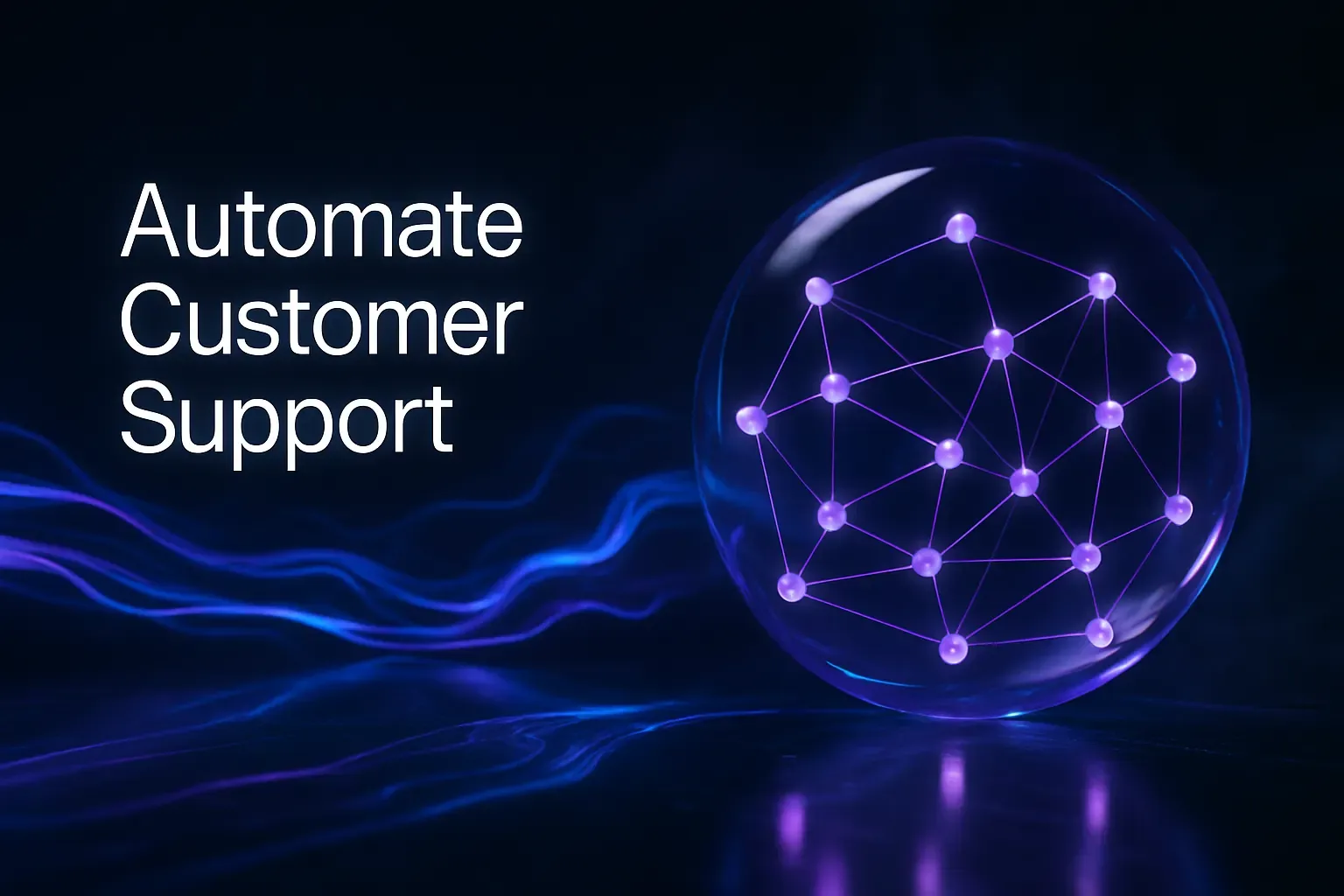When automation saves time but risks trust
Automating support promises relief for overloaded queues and greater efficiency. In B2B SaaS, though, expectations are high, buyers want clarity, relevant context, and personalized care. Poorly designed automation can break those expectations, slowing deals and increasing customer churn.
Below are six common mistakes that can undermine your support automation, and how you can avoid them to maintain your customers’ trust.
Mistake 1: Automating the wrong journeys
Not every support process should be automated. Start by automating only repetitive, low-risk tasks so that your team can focus on handling complex or high-value conversations that require a human touch. Select automation opportunities based on how they might affect your revenue and risk profile.
Automate these first
- Password resets and login support.
- Providing invoice copies and payment confirmations.
- Updating users on order status, usage limits, and plan details.
- Basic troubleshooting steps that are straightforward and easily reversible.
Keep these with agents
- Changes to contracts and pricing exceptions.
- Responding to security incidents or data access requests.
- Addressing custom integrations or API outages.
- Managing renewals that involve upsell opportunities or accounts flagged as being at risk.
Begin by introducing automation to a small segment of your audience. Start with customers who typically resolve issues independently through self-service, then consider moving to mid-sized companies, and lastly, your enterprise-level clients.
Mistake 2: Treating setup as a one-time project
Your product and data evolve regularly, and so should your automated support. Automation should be managed as an ongoing process rather than a one-off project. Assign clear responsibility for updates and schedule regular reviews.
Set a maintenance rhythm
- Review support transcripts each week to identify solution gaps, incorrect answers, and misunderstood inquiries.
- Update your database monthly by adding fresh articles and removing outdated information.
- Fine-tune your prompt logic monthly, documenting changes and their effects.
- Run quarterly A/B tests on automated conversations and system responses.
- Maintain a record of updates and changes made to your system (a “change log”). Share this with your support and product teams to keep everyone aligned.
Coordinate with your product teams. Use the most commonly asked questions from customers to inform your product’s development and strategic planning. Publish new release notes using the bot’s voice to keep everyone informed.
Mistake 3: Letting your bot speak like a robot
Your buyers expect clear, human language, especially in B2B settings. Create a style guide for all automated responses, including examples for greetings, apologies, and escalation handovers.
Shape your prompts to match your brand’s voice. Avoid unnecessary jargon, use an active voice, and favor concise sentences. Test your bot’s replies using real support transcripts to ensure they feel natural and authentic.
It’s important to remember that clear, straightforward answers are better than complex or overly clever ones in automated support. Being precise and giving accurate information builds trust in your automated system.
If the responses from your chatbot seem unnatural or off, begin by reviewing and adjusting the language your bot uses. This guide outlines common chatbot issues and how to improve them quickly. Consider sharing it with your team.
Mistake 4: Ignoring context from your stack
Automated answers without context will feel generic and unhelpful. Integrate your Customer Relationship Management (CRM) system, billing details, and other sources of information about customer interactions, such as product analytics. Give your virtual assistant access to the same information as your agents, otherwise, your automation will make uninformed guesses.
Context that improves replies
- Customer segment, service tier, and service-level agreement (SLA).
- Current subscription, any add-ons, and usage limits.
- Open support tickets and recent product activity.
- Renewal dates and risk assessment scores.
Set guardrails for privacy and security: Only provide users with information they have permission to view, and never reveal private data in chat. Tools such as Typewise integrate directly with CRM, email, and chat platforms, keeping replies accurate and contextually aware.
Mistake 5: No clear escalation path
Effective self-service automation includes an easy safety net for when human intervention is needed. Establish clear policies and trigger points for handing off complex issues to agents. Make sure escalation feels seamless for users.
Escalation triggers to set up
- High-value accounts or strategic deals.
- Concerns about security, legal matters, or privacy.
- Billing disputes or cases at risk of a chargeback.
- Repeated failed resolutions during a session.
When escalating, transfer all relevant context, such as the user’s intent, a brief summary, and steps already taken, to the agent. Keep the customer in the same channel whenever possible to prevent frustration from repeated explanations or switching platforms.
Mistake 6: Reporting vanity metrics
Counting only automated case deflections can mask underlying problems in your support flow. Instead, use a balanced set of metrics that link automation to both customer experience and business outcomes. Share findings with your sales and customer success teams.
Metrics that actually reflect performance
- First response time for both bot and human replies.
- Resolution rate and speed of resolution.
- Customer effort score and user sentiment by issue type.
- Renewal and expansion rates for accounts assisted by automation.
- Rates of escalation and successful saves after escalation.
Pair these metrics with regular qualitative reviews: Read a sample of failed support interactions each week to quickly identify and fix recurring issues.
Selecting tools without bias
Choose a platform that is compatible with your existing technology and is well-suited to the size and growth stage of your business. Seek solutions with built-in privacy protections, robust integrations, and flexible control over communication style. Run a brief pilot before making a long-term commitment.
- Intercom Fin. Works seamlessly within Intercom, offering a strong chat experience and easy routing.
- Typewise. Excels at ensuring your communication stays on brand, with strong privacy features. Integrates with CRM, email, and chat, ideal for consistent messaging across channels.
- Zendesk Advanced AI. Deep integration with Zendesk’s tools, comprehensive analytics, and a thriving app marketplace.
- Freshdesk with Freddy AI. Great for growing teams, offering useful templates and pricing, and easy automation of straightforward processes.
Ask each vendor for proof of important features: Can it trace every answer to its source? Can it redact private data appropriately? Can it pass full customer context to human agents?
Make automation feel human
Successful automation combines context, speed, and empathy. It provides timely, relevant, and accurate answers, uses a human tone, and knows when to bring in a person. Treat your automation program as a living system, adjusting it as needs change. You can achieve efficiency and preserve trust at the same time.
Want to see this approach in action? If you’re planning to launch or overhaul your automation, start a conversation with Typewise. Bring your unique workflows and communication style, we’ll show you practical ways to align automation with your goals and your team's voice.
FAQ
What are the risks of automating inappropriate support processes?
Automating the wrong processes can frustrate customers and erode trust. It may result in slow resolutions and irreparable damage to customer relationships, ultimately impacting your bottom line negatively.
Why should support automation be an ongoing process rather than a one-time setup?
Support systems need continuous updates to stay relevant. Stagnant automation can mislead customers with outdated information, hindering progress and causing dissatisfaction.
How can a lack of personalized responses affect customer trust?
Generic responses can make your company appear out of touch with customer needs. Failing to use customer-specific context could lead to a decrease in loyalty and an increase in customer churn.
What is the importance of setting up clear escalation paths in support systems?
Without clear escalation paths, complex issues stay unresolved, leading to customer frustration. Seamless hand-offs with all context transferred ensure higher success in meeting customer expectations.
Are vanity metrics reliable indicators of automated support performance?
Vanity metrics often disguise the real impact of automation. A focus on numbers like case deflection without considering customer satisfaction can misrepresent performance and hide underlying issues.
How can you ensure that automated responses align with your brand's voice?
Integrate a style guide into your automation system to maintain consistency. Regularly testing responses against real interactions can prevent robotic or misaligned communications.
Why is it critical to incorporate customer context into automated responses?
Ignoring customer context results in responses that feel impersonal and inadequate. Such oversight can severely impair your ability to resolve issues effectively, damaging customer relationships.
What should be considered when choosing automation tools for support?
Select tools that align with existing systems and ensure data privacy. Prioritize those offering seamless integrations and robust control over communication for effective and secure automation.





